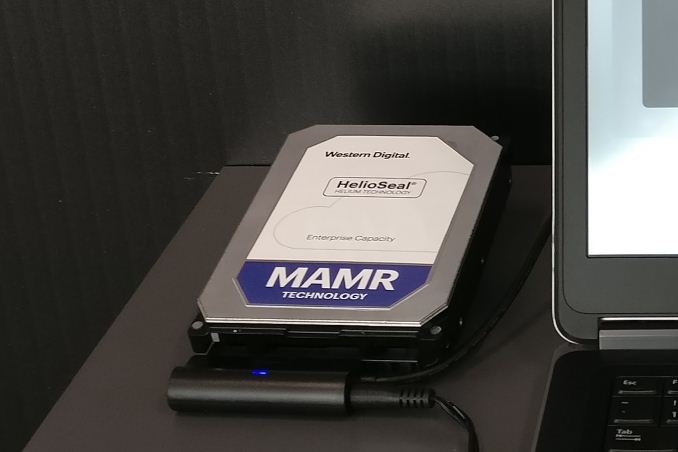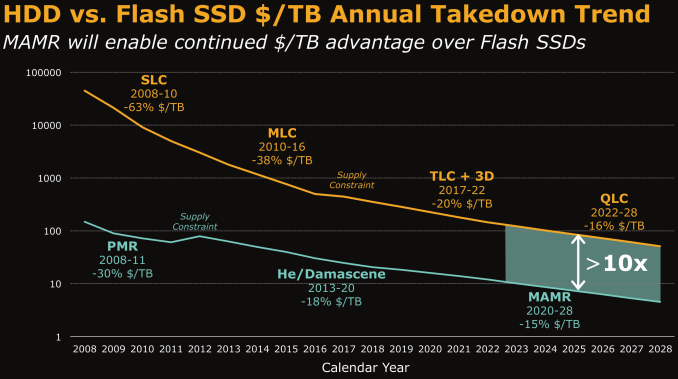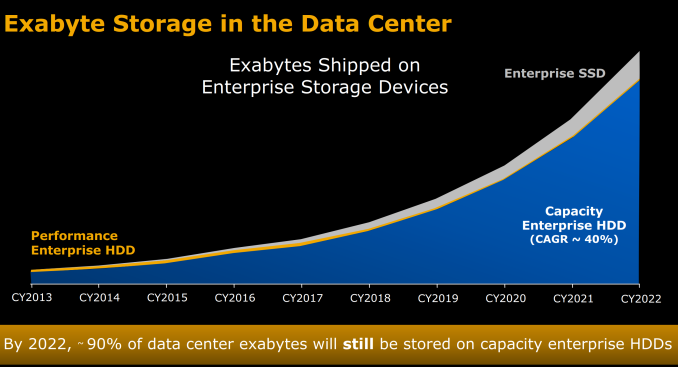Western Digital Stuns Storage Industry with MAMR Breakthrough for Next-Gen HDDs
by Ganesh T S on October 12, 2017 8:00 AM EST
Yesterday, Western Digital announced a breakthrough in microwave-assisted magnetic recording (MAMR) that completely took the storage industry by surprise. The takeaway was that Western Digital would be using MAMR instead of HAMR for driving up hard drive capacities over the next decade. Before going into the specifics, it is beneficial to have some background on the motivation behind MAMR.
Hard drives may be on the way out for client computing systems, but, they will continue to be the storage media of choice for datacenters. The Storage Networking Industry Association has the best resources for identifying trends in the hard drive industry. As recently as last year, heat-assisted magnetic recording (HAMR) was expected to be the technology update responsible for increasing hard drive capacities.

Slide Courtesy: Dr.Ed Grochowski's SNIA 2016 Storage Developer Conference Presentation
'The Magnetic Hard Disk Drive: Today’s Technical Status and Its Future' (Video, PDF)
Mechanical Hard Drives are Here to Stay
One of the common misconceptions amongst readers focused on consumer technology relates to flash / SSDs rendering HDDs obsolete. While using SSDs over HDDs is definitely true in the client computing ecosystem, it is different for bulk storage. Bulk storage in the data center, as well as the consumer market, will continue to rely on mechanical hard drives for the foreseeable future.
The main reason lies in the 'Cost per GB' metric.
Home consumers are currently looking at drives to hold 10 TB+ of data, while datacenters are looking to optimize their 'Total Cost of Ownership' (TCO) by cramming as many petabytes as possible in a single rack. This is particularly prevalant for cold storage and archival purposes, but can also expand to content delivery networks. Western Digital had a couple of slides in their launch presentation yesterday that point towards hard drives continuing to enjoy this advantage, thanks to MAMR being cost-effective.
Despite new HDD technology, advancements in solid state memory technology are running at a faster pace. As a result SSD technology and NAND Flash have ensured that performance enterprise HDDs will make up only a very minor part of the total storage capacity each year in the enterprise segment.
The projections presented by any vendor's internal research team always need to be taken with a grain of salt, but given that SanDisk is now a part of Western Digital the above market share numbers for different storage types seem entirely plausible.
In the next section, we take a look at advancements in hard drive technology over the last couple of decades. This will provide further technical context to the MAMR announcement from Western Digital.












127 Comments
View All Comments
BrokenCrayons - Friday, October 13, 2017 - link
If you allow your hair to grow long enough, clothing isn't that important. Oooor, you could just move to the tropics.mkozakewich - Sunday, October 15, 2017 - link
Regarding clothing, there are a lot of older people who would think it fitting to denigrate kids who are wholly unable to make their own clothes, given cloth and needle and thread. It has more to do with the knowledge and appreciation of the craft than with doing everything on your own.surt - Sunday, October 15, 2017 - link
And a generation ago the elders scoffed at kids who didn't know how to shoe a horse. Elders are always scoffing, its hard to recognize or accept your obsolescence.Manch - Monday, October 16, 2017 - link
LOL, Oh damn, the script kiddie got triggered LMFAO! JK JK JK.....Seriously the term script kiddies is meant to be denigrating and its not meant to apply to you.cm2187 - Thursday, October 12, 2017 - link
Maybe you live in a datacentre, but for the rest of us, uploading 40TB worth of data through a DSL connection is a no go...DanNeely - Thursday, October 12, 2017 - link
... and even if you eventually did that, redownloading for a restore would still be nightmarish.I back up some stuff to the cloud, but full system images are local to the NAS on my LAN. (Currently WHS 2011 in a 2 disk RAID 1 equivalentish mode.)
alpha754293 - Thursday, October 12, 2017 - link
My apologies to you for using WHS 2k11.oynaz - Friday, October 13, 2017 - link
There are many places where 1 gigabit connections are commonplace though.BurntMyBacon - Friday, October 13, 2017 - link
@oynazSure. For people with access to a 1Gb internet connection, a cloud backup/restore is much less painful. Of course it would still take the better part of a 4 days. (1 Gb = 128 GB. roughly half the HDD data rate that cekim used in his calculation that revealed a 46 hour (46.6 actually) rebuild time.
However, people with access to such connections are still a vast minority. Despite availability of the service increasing, it is far from ubiquitous. Some providers (in certain countries) implement restrictive data caps so even if you can get gigabit internet, it will take months to backup or restore a 40TB drive from cloud without incurring penalties and/or throttling. Comcast, for instance, now has a data cap of 1TB a month (not sure about caveats as I don't live anywhere near Comcast territory ;' ) ). It would take 40 months to get 40TB of data restored without penalty.
someonesomewherelse - Saturday, October 14, 2017 - link
Download sure, upload not so much. Also using the cloud implies using encryption which is annoying.